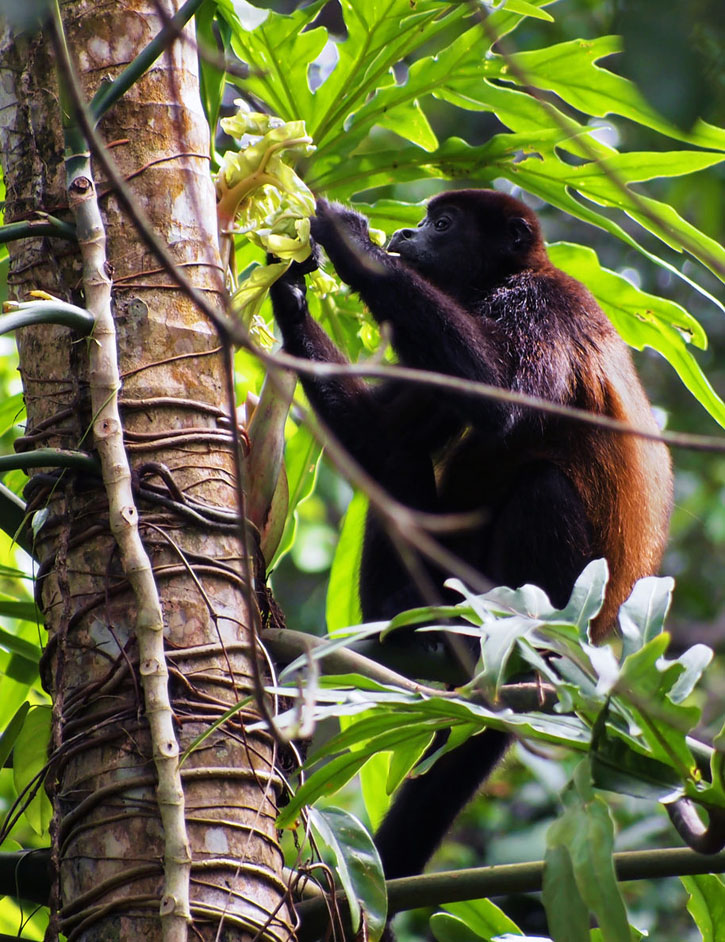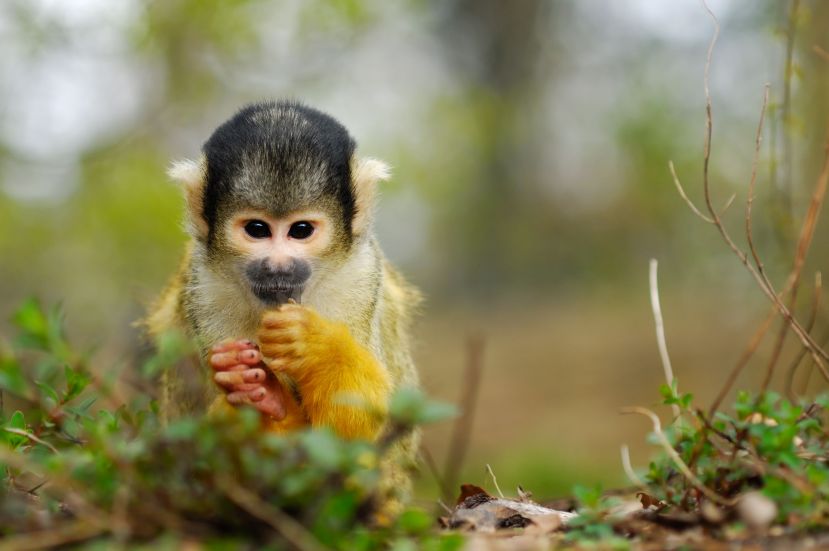Costa Rica has four species of monkeys: the white-faced (or capuchin), howler, spider, and squirrel. Along with approximately 50 other species, they belong to a group called New World monkeys. They inhabit a wide range of habitats, from the rainforest canopy to the scrubby undergrowth of the dry forests, though each species occupies its own niche and the species seldom meet. Together, they are the liveliest and most vocal rainforest tenants. Beyond the reach of most predators, they have little inhibition in announcing their presence with their roughhousing and howls, chattering, and screeches.

A mantled howler monkey, Alouatta palliata, eating leaves in Cahuita National Park, Costa Rica, Central America. Photo © vilainecrevette/123rf.
They are the liveliest and most vocal rainforest tenants. Beyond the reach of most predators, they have little inhibition in announcing their presence with their roughhousing and howls, chattering, and screeches.The distinctive-looking capuchin, or white-faced monkey (mono cara blanca), is the smartest and most inquisitive of Central American simians. It derives its name from its black body and monk-like white cowl. They’re the little guys favored by organ grinders worldwide. Capuchins range widely throughout the wet lowland forests and the deciduous dry forests of the northwest Pacific below 1,500 meters (4,900 feet) elevation. Two excellent places to see them are Santa Rosa and Manuel Antonio national parks, where family troops are constantly on the prowl. These opportunistic feeders are fun to watch as they search under logs and leaves or tear off bark as they seek out insects and small lizards. Capuchins also steal birds’ eggs and nestlings. While their taste is eclectic, they are fussy eaters: They’ll meticulously pick out grubs from fruit, which they test for ripeness by smelling and squeezing.The howler (mono congo) is the most abundant as well as the largest of Central American monkeys; it can weigh up to five kilograms (11 pounds). It inhabits both lowland and montane forests throughout Costa Rica and can be found clinging precariously to existence in many relic patches of forest. The stentorian males greet each new day with reveille calls that seem more like the explosive roars of lions than those of small arboreal leaf-eaters. The hair-raising vocalizations can carry for almost 1,500 meters (1 mile) in even the densest rainforest. The males sing in chorus again at dusk (or whenever trespassers get too close) as a spacing mechanism to keep rivals at a safe distance. Their Pavarotti-like vocal abilities are due to unusually large larynxes and throats that inflate into resonating balloons. Females generally content themselves with loud wails and groans—usually to signal distress or call a straying infant. This noisy yet sedentary canopy browser feeds on leaves and fruit.
The smallest and most endangered Costa Rican primate, the squirrel monkey (mono titi) grows to 25 to 35 centimeters (10-14 inches), plus a tail up to 45 centimeters (18 inches). Fewer than 2,000 individuals are thought to exist. It is restricted to the rainforests of the southern Pacific lowlands. Always on the go, day and night, they scurry about in the rainforest understory and forest floor on all fours. Squirrels are more gregarious than most other monkeys; bands of 40 individuals or more are not uncommon. The golden-orange titi, with its face of white and black, is the arboreal goat of the forest. It will eat almost anything: fruit, insects, small lizards. The titi is well on its way to extinction.

A small squirrel monkey sits on the jungle floor. Photo © EricGevaert/123rf.
The large, loose-limbed spider monkey (mono colorado)—the supreme acrobat of the forest—was once the most widespread of the Central American monkeys. The last few decades have brought significant destruction of spider monkey habitats, and land clearance and hunting have greatly reduced spider monkey populations throughout much of their former range. These copper-colored acrobats can attain a length of 1.5 meters (5 feet). They have evolved extreme specialization for a highly mobile arboreal lifestyle. Long slender limbs allow spider monkeys to make spectacular leaps. But the spider’s greatest secret is its extraordinary prehensile tail, which is longer than the combined length of its head and body. The underside is ridged like a human fingertip for added grip at the end of treetop leaps (it is even sensitive enough for probing and picking). You might see individuals hanging like ripe fruit by their tails. Gregarious by night (they often bed down in heaps), by day they are among the most solitary of primates. The males stay aloof from the females. While the latter tend to their young, which they carry on their backs, the males are busy marking their territory with secretions from their chest glands.
Excerpted from the Tenth Edition of Moon Costa Rica.